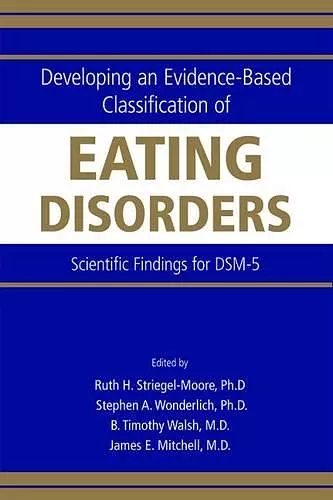Developing an Evidence-Based Classification of Eating Disorders
Scientific Findings for DSM-5
James E Mitchell editor Ruth H Striegel-Moore editor Stephen A Wonderlich editor B Timothy Walsh editor
Format:Paperback
Publisher:American Psychiatric Association Publishing
Published:23rd Apr '11
Currently unavailable, our supplier has not provided us a restock date

The culmination of several years of collaborative effort among eating disorders investigators from around the world, Developing an Evidence-Based Classification of Eating Disorders: Scientific Findings for DSM-5 provides summaries of the research presentations and discussions of the conceptual and methodological issues involved in diagnosing and classifying eating disorders. The mission of the DSM-5 Eating Disorder Work Group was to improve the clinical utility of eating disorder diagnoses by recommending revisions based on sound empirical evidence. Although the objective was to provide empirical information to the DSM-5 Eating Disorders Work Group, the research presented in this book should be invaluable to the eating disorders research and clinical community at large and, by extension, to their patients.
Eating disorders are serious, difficult to treat, and often lead to multiple medical complications, high rates of psychiatric comorbidity, and mortality. It is critical, then, that clinicians be aware of the most current research, as well as understand the foundation of the soon-to-be-released DSM-5.
Improving the definition of symptoms and syndromes is one of the critical challenges the authors tackle—in particular the validity of the eating disorders not otherwise specified category, into which 60% of patients diagnosed with an eating disorder now fall. In addition, other mental disorders, particularly mood disorders and anxiety disorders, co-occur at a higher rate than would be expected. These findings indicate the need for greater specificity in the nosology, an issue which the investigators address. Other topics addressed include:
• Eating disorders in children and adolescents, including diagnostic differences and classification. Also included is a chapter on the validity of applying a classification for feeding disorders in infants and young children, as well as one that covers latent profile analysis to identify eating disorder phenotypes in the adolescent population.
• Cultural considerations and cross-cultural variation in the classification of eating disorders, including Native American, Japanese, Canadian, and Pacific Fijian populations.
• A discussion of non-fat-phobic anorexia nervosa and its suitability for inclusion in DSM-5.
• Current and future directions for the assessment of the cognitive criteria for anorexia nervosa.
• A chapter on loss of control eating, including implications for future weight gain, depression, binge drinking, and substance abuse.
Key terms, references, summaries, charts, tables, and other illustrative features are abundant and...
This is a very important work in light of the imminent publication of DSM 5. A great deal of time and effort has gone into improving the diagnostic categories of eating disorders to make them more reliable and specific, and the book conveys that. The data are interesting and relative to anyone working with patients with eating disorders. However, the book is not for the casual reader. The chapters can be highly technical and dense. It is not, nor was it meant to be, a treatment guide for eating disorders. If you want to see how eating disorder nosology and taxonomy is created and the likely changes to DSM 5 and beyond, this is the book for you.
-- Brett C. Plyler, M.D. * Doody's Publishers' ClISBN: 9780890426661
Dimensions: 229mm x 152mm x 24mm
Weight: 689g
429 pages